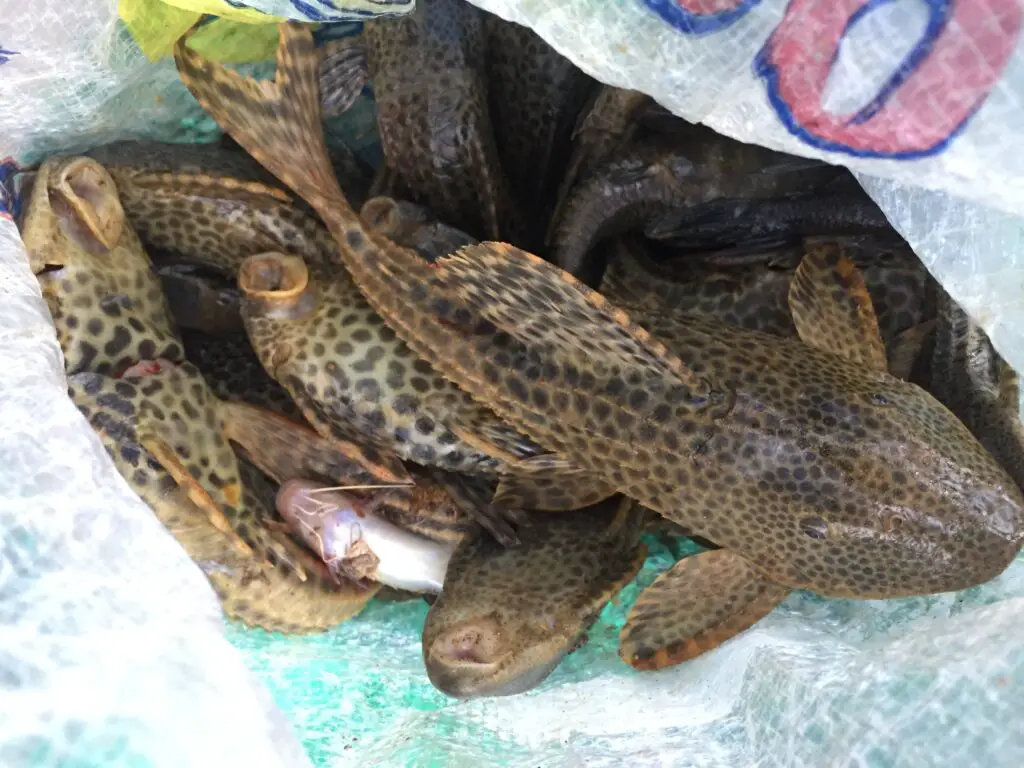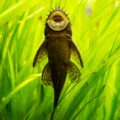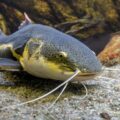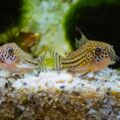The armored catfish (family Loricariidae) is an algivorous nocturnal fish with a prominent sucker on where their mouth is. When conditions are right, loricariids can grow up to three feet long. The bony plates that cover their bodies are what make them famous.
Habitat
In tropical South America, Costa Rica, and Panama, armored catfish can be found in most freshwater habitats but nevertheless, many species have constrained natural ranges. They can also be found in a few locations with brackish water. Most armored catfish are nocturnal creatures. While armored catfish often consume algae, insects, and debris, one genus, Panaque, is known to finish wood.
Biology
In its native South America, people eat armored catfish, especially in rural regions. Eaten whole, grilled, or in soups, it is a live offering in markets. In Brazil, armored catfish can also be ground into piracui (fish meal), which is combined with olive oil, onions, and cassava flour to produce fried dumplings. Due to their antagonistic impact on the balance of the environment, armored catfish have been added to the growing list of non-native fish in native waters and may not disappear very soon. They are listed as an invasive species by the state of Texas in their waterways.
Armored Catfish Appearance
When viewed from a distance, armored catfish resemble regular catfish. They feature a sizable suckermouth that faces downward, as you might assume, allowing them to suction-cling to surfaces. They lack distinct maxillary barbels, which resemble cat “whiskers,” found on most catfish species. Unlike cats, they are sensory organs that help the fish find food.
The armored catfish is a triangular fish covered in bony plates with a smooth bottom and leopard-spotted spots. There are no teeth in the mouth. Strong currents can also cause its “suckermouth” to attach to surfaces. Since it removes algae from the edges and bottom of tanks, the armored catfish is a common aquarium fish.

Diet and Food
Often, armored catfish are marketed as catfish that enjoy consuming algae. They are thus renowned for being superb algae feeders. They do consume carrion in the wild, although some of them are also carnivores.
Most other pleco species eat wood as food. You should conduct thorough research about the dietary requirements of a loricariid in order to provide it with the nourishment it requires for healthy growth. Bottom-feeder tablets are simple to provide in the tank. They also readily consume algae, tropical granules, shrimp pellets, and other foods.
Given their nocturnal tendencies, a lot of seasoned hobbyists typically feed plecos once or twice a week with a disc food or tablet. You must provide them with a variety of high-quality foods to ensure they receive the optimum nutrition and aid in their proper growth. Make sure you don’t give them a big supper. Make sure to feed your catfish small meals several times a day instead, or use the tablets as recommended above.
Temperament & Behaviour
The Loricariidae catfish family contains a great number of species, and their temperaments are very diverse. They often only exist at night. As a result, they will quickly avoid strong lighting.
They are also not aggressive at all. Alternatively, they get along with other tank mates well enough to do so.
Armored Catfish Scientific Classification
-
- Kingdom- Animalia
-
- Phylum- Chordata
-
- Class- Actinopterygii
-
- Order- Siluriformes
-
- Family- Loricariidae
Armored Catfish Physical Characteristics
-
- Colors- brown, grey, black, white, dark brown.
-
- Weight- Up to 3 lbs
-
- Length- 6-8 inches
-
- Age of Sexual Maturity- Usually 4-6 months
-
- Venomous- No
-
- Aggression- Low
Facts about Armored Catfish
-
- The body of an armored catfish is covered in bony or armor-like plates. As they lay flat against a rock or the bottom of a river or stream, these shield the fish from predators.
-
- Pectoral fins in armored catfish are robust. It will be more difficult for them to fit in the mouth of another fish or bird if they lengthen these fins, which will increase their overall size.
-
- They have gills, just like other fish, but they can also gulp air and store it in their stomachs. Because of this, they can survive for up to 30 hours without water.
-
- Armored Catfish have been observed moving erratically across the landscape in times of drought in order to reach locations with more water. They are able to do this thanks to their robust pectoral fins, flat body, and capacity for exhalation.
-
- Other Name(s)- Plecos, loricariids, Carachama, or Suckermouth armoured catfishes
-
- Optimum pH Level- 6.5 to 7.8
-
- Average Spawn Size- Several thousand eggs
-
- Habitat- Freshwater (and sometimes brackish)
-
- Predators- Fish, Birds, River Otters, and Crocodiles
-
- Lifestyle – Solitary
-
- Number Of Species- 684
Armored Catfish Types
In the family Loricariidae, there are more than 680 species of armored catfish. Among them are:
-
- Hypostomus plecostomus, also known as the “pleco,” is a typical fish seen in aquarium fish commerce. Pet owners can use these to clear the aquarium of algae and other contaminants. They have robust armor and a placid disposition, making it hard for other fish to harass.
-
- The Essequibo and Nickerie river drainage in Guyana is home to the tiny, armored catfish known as Hypoptopoma Guyanese. It barely gets to be around 2.5 inches long.
-
- In Brazil’s upper Parana River Drainage region, the armored catfish, Proloricaria prolixa, is indigenous. They can get as long as 13.8 inches.
-
- The Orinoco Sailfin Catfish is Pterygoplichthys multiracials. It possesses a dorsal fin resembling a sail and is distinguished by its speckled appearance. It is a well-liked aquarium “pleco” fish.
Species Overview
| Level of Care | Very easy |
| Appearance | Grey body with black dots all over |
| Temperament | Peaceful |
| Life Expectancy | 15 years |
| Size | 24 inches |
| Diet | Omnivores |
| Family | Loricariidae |
| Tank Size | 75-100 gallons |
| Tank Environment | A cave, a stone formation, and plants are present in slightly acidic or neutral water. |
| Tank Mates | Very peaceful |
Final Thoughts
-
- Are you considering giving your aquarium a fun makeover? In such cases, loricariids are simply wonderful pets. They roam around your tank with a playful attitude and are easy to care for. Though it lives in freshwater, the armored catfish can withstand typical salinity.
-
- Native indigenous species may be outcompeted and threatened by the overabundance of Loricariids in freshwater habitats. Together with the obvious ecological dangers, this might cause freshwater fisheries to fail. Do not release these into the wild if you have them as pets.











